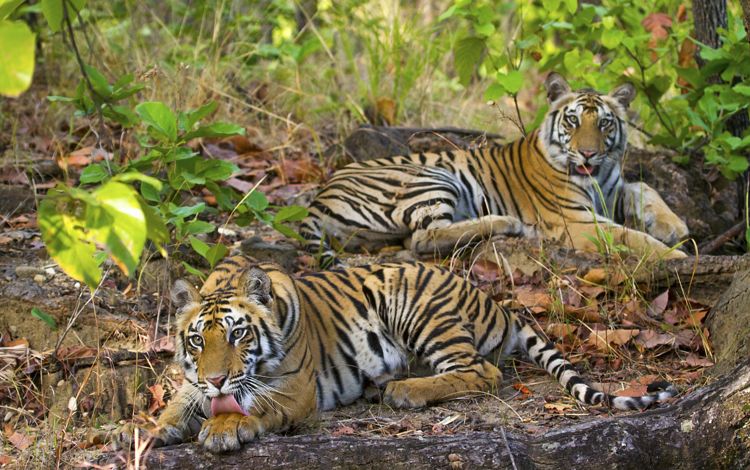Help us restore tiger habitat
Your support will help us create more riparian corridors to link existing tiger habitats.
Donate nowRecently an endangered Bengal Tiger was seen by villagers at Surajkund, Madhya Pradesh in an area near to a TNC India habitat restoration site at Dhansi. The nearby Satpura tiger task force set up camera traps in an attempt to verify the sightings. To everyone’s delight, not long after, on March 4th, a tiger unknowingly took the above photo of itself on a night-time stroll.
The presence of a tiger in the area provides encouragement that our River Narmada Project is on track to provide much needed extra habitat for tigers and the herbivores they prey upon along parts of India’s fifth largest river.
A third of Narmada’s river basin is forested and home of 17% of the world’s wild tigers along with 25 million people. Due to anthropogenic and climatic pressure the entire ecosystem of this iconic river basin is under threat, especially the riparian habitat – that which exists in the interface between rivers and surrounding lands.
To arrest further loss and revegetate the river’s riparian areas, TNC India is supporting the Madhya Pradesh government in providing a science-based solution to improve the impact of riparian habitat conservation work. Since 2017, we have undertaken scientific studies, build capacity of community members, developed local relationships and implemented restoration work in two riparian model sites – Dhansi and Ajera, in Hoshangabad district.
[Both sites are situated on the northern side of the central Narmada Valley and the Satpura Biosphere Reserve. The sites are highly archaeologically, paleontologically and culturally significant. It is here that an early hominid calvaria (the top part of a skull) was discovered from the Chibanian age. Famously known as ‘Narmada Man’ (Homo erectus narmadensis), the skull is dated at 780,000 years old.]
The ecological landscape between the Narmada River and the Satpura Tiger Reserve is fragmented due to extensive agricultural practices, deforestation and other development works. Conserving and restoring small linkage zones like riparian habitat is an important mitigation measures to reduce the human-caused landscape change that negatively impacts biodiversity. This improved connectivity acts like stepping stones, helping to preserve natural biological processes such as long range movements of many wide-ranging animals including the tiger. The Satpura Tiger Reserve has 50 tigers, and they move freely through degraded forest patches and agricultural land for prey and other activities.
Quote
Our improved thin riverine riparian forest strips act as a functional corridor for many wildlife including tigers, other carnivores, grassland birds, raptors, butterflies, spotted deer, blackbuck, reptiles and many others.
We have documented 70 birds and 30 butterflies from these two sites along with 38 tree, 11 shrub, 84 herbs 9 climber and 15 grass species.
Gradual improvement in the riparian sites means they are now acting as both structural and functional corridors for flora and fauna species, motivating local community members who are coming forward to actively protect and preserve their mystical Narmada riparian land.
Wildlife and landscapes of the area




A brief, sad history of global tiger decline
Being amongst the most beautiful and powerful of all animals on Earth has sadly not spared the mighty tiger from a sad and tragic decline. Originally spanning much of Asia from Turkey in the west to Russia and North Korea in the east; southwards from the foothills of the Himalayas in Nepal, Bhutan and India to equatorial Indonesia. Highly adaptable they inhabit marshlands, woodlands and forests that can be deep in snow in winter (Siberia) or hot and wet all year round (Sumatra).
Due to a range of human induced pressures – most significantly poaching for the illicit eastern medicine trade and the loss of habitat and/or prey species within remining habitat – tigers have suffered catastrophic decline. Bali, Caspian and Javan Tigers are all extinct, exterminated by the 1950s (Bali) and the late 1970s (Caspian and Javan). Today the total global wild tiger population is somewhere between 4,500 and 5,500 tigers – less than the number in captivity.
But there is hope in India
India’s Bengal Tigers are faring better than other surviving tiger types actually increasing to a population of an estimated 3,000 by 2019 – around 60% of all wild tigers.
